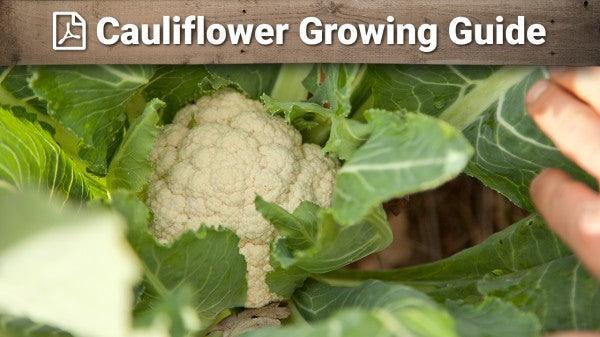Cauliflower, a member of the brassica family, is a rewarding but challenging vegetable to grow. With the right techniques and care, you can enjoy a bountiful harvest of nutritious, flavorful heads. This guide covers everything from cauliflower varieties and planting techniques to pest management and harvesting tips.
Click here to access the complete Cauliflower Growing Guide (PDF) for detailed information on soil preparation, planting, and long-term care.
Popular Cauliflower Varieties
• Cheddar: Orange heads with high nutritional value. Color becomes brighter when cooked. 60 days to harvest (Hybrid).
• Flowering (Fioretto, Karifurore): White flowering heads with sweet, edible stems. 70 days to harvest (Hybrid).
• Purple: Large purple heads that turn green when cooked. Highly disease-resistant. Best planted in July/August for a spring harvest (200 days to harvest, Heirloom).
• Romanesco: Light green spiral heads with a delicate flavor. Best for fall harvest (75–100 days, Heirloom).
• Traditional (Snowball): Firm, pure white heads with a delicate flavor. Suitable for spring or fall planting (52–70 days, Heirloom).
Best Growing Conditions for Cauliflower
Soil and Temperature:
• Soil pH: 6.0–7.0, rich in organic matter, and well-draining.
• Temperature: Ideal germination at 60–65°F; tolerates 50–80°F.
• Air Temperature: Best around 75°F, avoid temperatures below 25°F.
• Spacing: Plant 15–24 inches apart, with rows spaced 24–36 inches.
Companion Planting:
• Good Companions: Radishes, cucumbers, chard, broccoli, beets, onions, sage, thyme.
• Avoid: Peas, strawberries, and tomatoes.
Watering:
• Cauliflower needs consistent, deep watering for proper head formation.
• Use mulch to retain moisture and drip irrigation to prevent disease from overhead watering.
Planting and Growing Cauliflower
Spring Planting:
• Start seeds indoors 5 weeks before the last frost.
• Sow seeds ¼–½ inch deep in a soilless seed starting mix like Quickroot.
• Keep seed beds moist and at 60–65°F.
• Transplant seedlings outdoors when they have 4–6 true leaves and soil reaches 60°F.
Summer Planting (for Fall Harvest):
• Direct seed in July/August, covering seeds with loose soil or compost.
• Keep soil moist and protect seedlings with light row covers like Agribon AG15.
• Romanesco and Purple varieties are best for fall harvests, while Snowball can be planted in August.
Transplanting Tips:
• Bury plants to the first true leaf in well-drained soil.
• Maintain 18-inch spacing with 25 inches between rows.
• Provide consistent water and balanced fertilizer to avoid plant stress.
Harvesting Cauliflower
When and How to Harvest:
• Harvest heads when they are tight and reach 6–8 inches in diameter, but before they begin to flower.
• Cut stems, leaving a few protective leaves around the head to prolong freshness.
• Store harvested cauliflower in the refrigerator for up to a week.
Blanching for White Heads:
• To maintain a white color for varieties like Snowball, gather the outer leaves over the head and tie them with string or a rubber band.
• Begin blanching 1–4 weeks before harvest, depending on the weather.
Common Cauliflower Pests and Diseases
Pests:
• Aphids: Found under leaves or on heads. Control with strong water sprays or organic insecticides.
• Cabbage Loopers: White moth larvae that chew leaves. Handpick or use organic insecticides.
• Flea Beetles: Cause tiny holes in leaves. Use floating row covers (e.g., Agribon AG19).
• Root Maggots: Lay eggs near roots, causing decay. Use row covers and organic soil treatments.
Diseases:
• Blackleg: Causes yellow spots with gray centers. Avoid overhead watering and use organic fungicides.
• Alternaria Leaf Spot: Causes dark spots and leaf drop. Use organic fungicides and rotate crops.
• Clubroot: Creates swollen roots and wilted plants. Practice crop rotation and remove infected plants.
Common Growing Problems and Solutions
Why Do Cauliflower Heads Splay Out Instead of Staying Compact?
• Caused by excess heat, sunlight, or nitrogen. Use heat-tolerant varieties and maintain proper nitrogen balance.
Why Don’t Heads Form on Established Plants?
• Temperatures that are too hot or dry hinder head formation. Use cold-tolerant varieties and maintain consistent watering with mulch.
How Can the Harvest Season Be Extended?
• Succession Planting: Plant different varieties with varying maturity dates.
• Variety Selection: Choose varieties suited for spring, summer, and fall plantings.
Why Grow Cauliflower?
• Nutrient-Rich: High in fiber, vitamins C and K, and antioxidants.
• Variety of Colors: Grow white, purple, orange, and green heads for visual appeal and flavor diversity.
• Versatile in the Kitchen: Use cauliflower for roasting, mashing, stir-fries, and soups.
• Cold-Season Favorite: Thrives in early spring and fall gardens.

